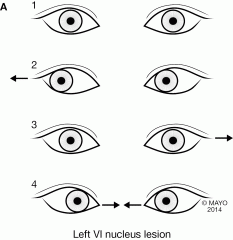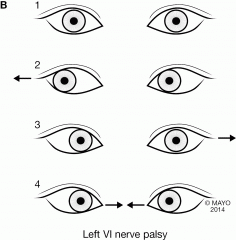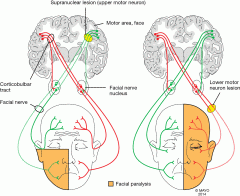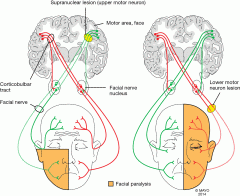![]()
![]()
![]()
Use LEFT and RIGHT arrow keys to navigate between flashcards;
Use UP and DOWN arrow keys to flip the card;
H to show hint;
A reads text to speech;
51 Cards in this Set
- Front
- Back
|
Components of cranial nerve V |
3 sensory (GSA) and 1 motor (SVE) component |
|
|
Ganglion/nuclei of CN V (4) |
SVE - motor nucleus GSA - trigeminal ganglion, spinal tract and nucleus GSA - trigeminal ganglion, chief principal nucleus GSA - mesencephalic nucleus |
|
|
Function of trigeminal ganglion, spinal tract and nucleus? |
Ipsilateral pain and temperature sensation to face, supratentorial dura |
|
|
Function of trigeminal ganglion, chief principal nucleus? (3) |
Vibration, proprioception, tactile discrimination of ipsilateral face |
|
|
Function of mesencephalic nucleus? (2) |
Unconscious proprioception of jaw; reflexive chewing |
|
|
Other names for the trigeminal ganglion? |
Gasserian ganglion or semilunar ganglion |
|
|
Dysfunction of the trigeminothalamic tract results in what? |
Ipsilateral loss of pain and temperature of the face |
|
|
What makes the mesencephalic nucleus of CN V unique? |
It is within the body of the midbrain and not a ganglion cell body |
|
|
An upper motor lesion of the SVE component of CN V results in? |
No significant weakness because of bilateral corticobulbar input |
|
|
A lower motor neuron lesion of the SVE component of CN V results in? |
Jaw deviating to the weak side |
|
|
Function of cranial nerve VI |
Motor nerve (GSE) and innervates the ipsilateral lateral rectus, which functions to abduct the eye |
|
|
Where are the paired abducens nuclei located? |
In the dorsal lower portion of the pons, separated from the floor of the fourth ventricle by the genu of the facial nerve (facial colliculus) |
|
|
Course of the abducens nerve complex |
The abducens motoneurons are intermixed with internuclear neurons that send their axons across the midline to the opposite medial longitudinal fasciculus (MLF), where they ascend through the pons and midbrain to end in the third nerve nucleus. Thuis, the abducens nuclear complex coordinates the action of both eyes to produce horizontal gaze |
|
|
Lesions affecting the axons of cranial nerve VI result in? |
Ipsilateral lateral rectus palsy (poor abduction of the ipsilateral eye) |
|
|
Lesions affecting the abducens nucleus will result in? |
Ipsilateral rectus paresis and ipsilateral gaze palsy to the same side because the abducens interneurons are involved |
|
|
Draw the positions of eyes in a left CN VI nucleus lesion |

|
|
|
Draw the positions of eyes in a left CN VI nerve palsy |

|
|
|
Components of CN VII |
5: 2 sensory (SVA, GSA) and 3 motor (GVE x2, SVE) |
|
|
What is the nervus intermedius? |
The GVE, SVA, and GSA fibers of CN VII |
|
|
Where in the pons is the motor nucleus of CN VII found? |
In the caudal pons |
|
|
Axons of CN VII innervate what? |
Muscles of facial expression and the stapedius muscle (functions to dampen sound) |
|
|
Corticobulbar input to the forehead is (unilateral/bilateral)? |
Bilateral |
|
|
Corticobulbar input to the lower part of the face is (unilateral/bilateral)? |
Unilateral |
|
|
An upper motoneuron lesion to CN VII will result in? |

Contralateral paralysis of the lower part of the face only |
|
|
A lower motor neuron lesion to CN VII will result in? |

Paralysis of the entire ipsilateral face |
|
|
Cranial nerve VII has 2 GVE components. Where do they originate? |
The first originates in the superior salivatory nucleus and the other in the lacrimal nucleus |
|
|
Components of cranial nerve VIII |
Two types of SSA: vestibular and cochlear |
|
|
Role of the vestibular component of CN VIII |
To control posture and movements of the body and eyes relative to the external environment; in addition, it serves to control eye movements and posture relative to linear and angular acceleration |
|
|
Dsyfunction of the vestibular component of CN VIII may result in? (4) |
Vertigo, nystagmus, nausea, and imbalance |
|
|
Monaural information is carried in what fashion? |
Contralaterally to the inferior colliculus |
|
|
The 2 GVE (parasympathetic) components of cranial nerve VII innervate what? (4) |
The lacrimal glands and nasal mucosa, as well as the sublingual and submandibular salivary glands |
|
|
The SVA fibers of CN VII carry what information? |
Taste information from the ipsilateral anterior two-thirds of the tongue to the rostral aspect of nucleus solitarius via the geniculate ganglion |
|
|
Clinical result of a lesion in the cochlear nerve? |
Ipsilateral deafness (partial or complete), tinnitus |
|
|
Potential causes of lesion in the cochlear nerve? (5) |
1. Trauma 2. Infection 3. Drugs (e.g., streptomycin) 4. AICA aneurysm 5. Cerebellopontine angle tumors |
|
|
Clinical result of unilateral brainstem lesion? |
Poor hearing localization (if lesion above and not involving cochlear nuclei) |
|
|
Potential causes of unilateral brainstem lesion? (3) |
1. Stroke 2. Tumor 3. Multiple sclerosis (MS) |
|
|
Clinical result of bilateral brainstem lesion? |
Possible bilateral hearing loss if severe bilateral brainstem lesions |
|
|
Potential causes of bilateral brainstem lesion? (3) |
1. Stroke 2. Tumor 3. Multiple Sclerosis (MS) |
|
|
Clinical result of unilateral auditory cortex lesion? |
Possible difficulty localizing sound |
|
|
Potential causes of unilateral auditory cortex lesions? (3) |
1. Stroke 2. Tumor 3. Trauma |
|
|
Clinical result of unilateral dominant posterior temporal lesion or bilateral temporal lesion? |
Pure word deafness (auditory verbal agnosia): inability to understand spoken language despite normal hearing acuity and ability to read, write, and comprehend environmental sound |
|
|
Potential causes of unilateral dominant posterior temporal lesion or bilateral temporal lesion? |
Structural lesions (stroke, tumor, trauma) |
|
|
Afferent and efferent limbs of the corneal reflex? |
Afferent - CN V1 via spinal tract and nucleus of CN V Efferent - CN VII, the facial nerve |
|
|
What is the jaw jerk ? |
A contraction of the masseter and temporalis muscles when the patient's lower jaw is tapped |
|
|
Limbs of the jaw jerk reflex? |
Afferent - CN V3 (mandibular), enter pons and travel to their cell bodies in the mesencephalic nucleus of CN V Efferent - motor nucleus of the trigeminal nerve |
|
|
Lesions anywhere along the jaw jerk reflex arc will result in? |
Depression of the ipsilateral jaw reflex, whereas bilateral supranuclear lesions result in an accentuated response |
|
|
Which nerves travel through the cavernous sinus? |
CN III, IV, VI; V1 and, in some, V2 |
|
|
Symptoms of cavernous sinus fistula? (4) |
Proptosis, arterialization of the episcleral and conjunctival veins due to backfill from the cavernous sinus into the superior ophthalmic veins, and an ocular bruit; tinnitus may also be present |
|
|
Locked-in syndrome is due to? |
Large pontine ischemic stroke, which is often due to basilar artery occlusion |
|
|
Patients with locked-in syndrome present with? |
1. Horizontal gaze palsy (bilateral abducens nuclear lesions) with intact vertical gaze 2. Paralysis of the limbs (corticospinal and corticopontine fibers) 3. Paralysis of the face (corticobulbar tract or the nucleus of CN VII) 4. Inability to speak, but with preserved cognition |
|
|
"Trick" to help distinguish a patient with locked-in syndrome from a comatose patients? |
Communication with vertical eye movement codes (e.g., look up twice for yes) |

